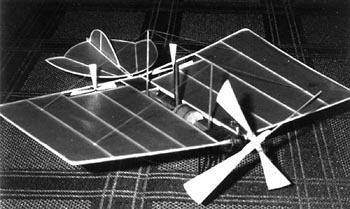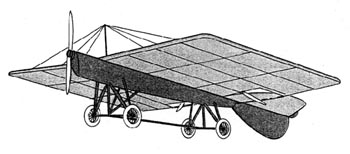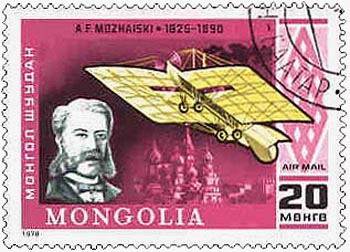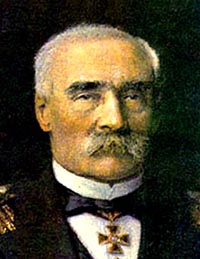
Alexandr Fyodorovich Mozhaisky (1825-1890)
also Alexander Feodorovitch Mozhaiski, Mozhaiskii Alexandr Fyodorovich Mozhaisky, Russian naval officer, aviation pioneer, researcher and inventor in the design of heavier-than-air-craft. The son of a naval officer, he was born on March 9 (21), 1825 in Rochensalm, Viborg district (now present-day Kotka, Finland).
 Model of Mozhaisky monoplane of 1884 by Tim Hayward-Brown
Tim Hayward-Brown wrote to a fellow contributor to this website New Zealander Paul Dunlop...
In 1993 I built a Pistachio (8inch span) model of the Mozhaiski 1884 Steam-Powered monoplane and sent it by mail to compete in the Nagoya Nuts Postal competition. It was proxy flown by the late Shoichi Uchida and achieved times of 30 and 40 seconds and eventually placed about 6th. In the 1860's he began to give serious thought and consideration to the possibility ofcreating a flying machine which was heavier than air. He studied the structure of birds' wings, determining the relationship between the wing areas and the weight of birds of various species. He next turned his attention to the flights of air kites. At the same time he studied the work of air screws. it was at this time that he sought and received from the Military Ministry funding for his research. But in 1878 when he sought a new commission from the government, that request was denied and he had to proceed on his own. For the study of the resistance of air to the movement of bodies, Mozhaiskii created an original experimental apparatus with the aid of which he carried out very accurate determinations of aerodynamic strength. On June 4,1880 he petitioned to receive a license for his airplane and on November 3, 1881 he received the first patent in Russia for his invention.
 Model of Mozhaisky monoplane of 1884 details tba
He had submitted drawings which showed that he had all of the five basic parts of the contemporary airplanes: wings, hull, power arrangement, tail assembly, and chassis. in 1881, with a government grant of 2,500 rubles, he purchased two 20- and 10-horsepowersteam engines for his "flying device". The construction was completed by 1882, but the record of the flight has not been preserved. Nevertheless this was the first time in the world that there had been a flight of a heavier-than-air "flying machine". What records that do exist indicate that his attempt resulted in the crash of his "flying machine", but that he continued with his research into aerodynamics and air propellers. The significant contribution which Mozhaiskii from a historical point of view made lay in the fact that he made the first practical attempts to build a piloted air craft. He died in Saint Petersburg on March 20 (April 1), 1890 - Mongolia C101; Russia 2772; 4303
 Anniversary stamp details tba
Alexander F. Mozhaiski http://home.earthlink.net/~rastagnac/contro.html 1884 -- Alexander Feodorovich Mozhaiski, Russian Empire: Mozhaiski may have had some success getting his large machine into a glide from a downhill ramp, but pre-Soviet evidence suggests it quickly tipped over on one wing. Judging from the design of the plane and its similarity to others being experimented with in England at the time, it's unlikely he was ever able to take off from a flat surface. Under Stalin's reign, Mozhaiski was put forward as the inventor of the airplane.
Steam-powered monoplane 1884 Built by Alexander Fedrovich Mozhaiskii. Plane used one 20hp engine (driving one propeller) and one 10hp engine driving 2 propellers. Both steam powered. 74ft span. 46ft long. The machine was released down an incline and made a "hop" of 65-100ft.
Alexander F. Mozhaiski Alexander F. Mozhaiski, Russia, builds a steam-powered monoplane and tests it at Krasnoye Selo, near St. Petersburg. It takes off on a jump ramp and flies for approximately 100 feet before crashing. This is the second power-assisted take-off in history.
also...
Captain Aleksander Mozhaiskii - Daguerrotypist The earliest known authenticated picture of a Japanese was a daguerreotype taken by Baltimore photographer Harvey R. Marks (1821-1902) in the USA in 1851. Marks photographed some of the survivors from crew of a Japanese ship who had been rescued and brought to San Francisco in 1851, notably 'Sam Patch' the cook. Several of these daguerreotypes are still in museum collections. Sam Patch went back with a US Navy squadron under the command of Commodore Perry, whose aim was to force Japan to open up to trade with the US. The official photographer on this expedition, Eliphalet Brown, Jr (1816-1886), took over 200 daguerreotypes and demonstrated the process in 1854, photographing a number of selected Japanese women, including a courtesan. Few of these pictures have survived. Perry's expedition led to the arrival in 1856 of US consul Townsend Harris together with a Dutch interpreter, Henry Heusken (they were the only Europeans in Japan outside of Nagasaki at the time). Heusken was also a photographer, and among his students was Renjo Shimooka who opened a photo studio in Yokohama in 1862.. Russia had also sent naval expeditions in 1853 and 1854 and had also brought a daguerreotypist, Captain Aleksander Mozhaiskii in 1854.
PhotoGuide Japan/PhotoHistory 1646-1867 : 1853-1854 Commodore Perry's naval squadron arrives in Japan and the official photographer, Eliphalet Brown, Jr. (1816-1886) took some 200 daguerreotype photos of people and scenics in Shimoda (Shizuoka Pref.) and Hakodate (Hokkaido). He thus became the first person to photograph the Japanese in Japan. Some of these images were used to make lithographs which found their way in A Journal of the Perry Expedition to Japan 1853-1854 by Samual Wells Williams, published in 1856. The print shop which printed this document was destroyed by fire and almost all of Brown's original daguerreotypes were lost. Only five are known to have survived. Perry's mission leads to the opening of Shimoda (Shizuoka Pref.) that year and of Hakodate in Hokkaido in 1855 as treaty ports. After Perry left Japan, a Russian ship with photographer Captain Aleksander Mozhaiskii arrived. He took daguerreotype photos in Japan. One of the images is preserved at Gyokusenji Temple in Shimoda, Shizuoka Pref.
|
© Copyright 1999-2002 CTIE - All Rights Reserved - Caution |

